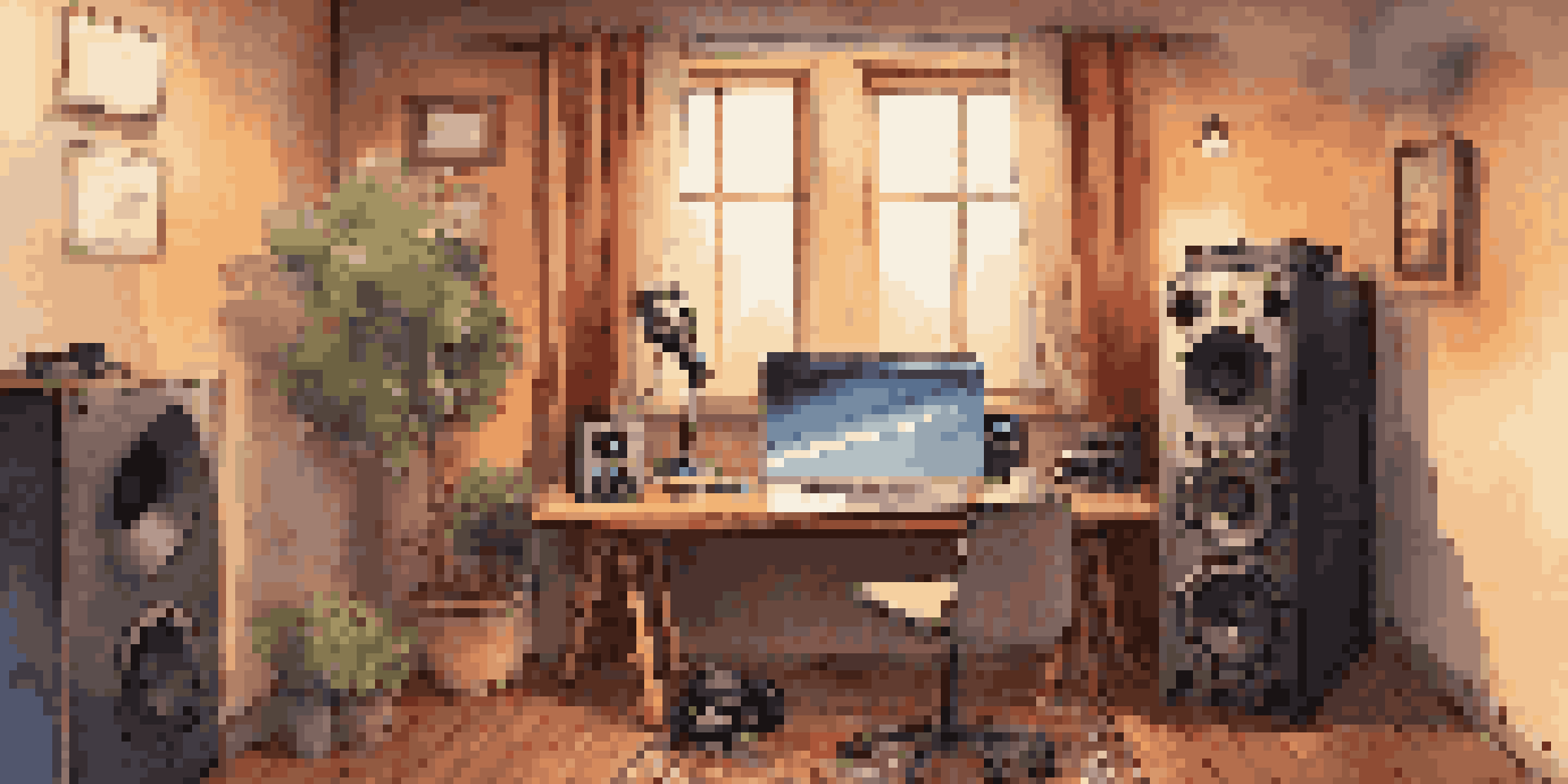Tips for Recording High-Quality Podcasts from Home on a Budget

Choosing the Right Microphone for Your Podcast
When it comes to podcasting, the microphone is your best friend. A good quality microphone can make a world of difference in your sound quality. You don’t have to splurge on a high-end model; even budget-friendly options like USB microphones can deliver impressive results.
The quality of your podcast is only as good as the quality of your audio.
Consider microphones like the Audio-Technica ATR2100x or the Blue Snowball. Both are affordable and user-friendly, making them perfect for beginners. Plus, they provide clear audio that captures your voice without unnecessary background noise.
Remember, investing in a decent microphone is crucial for building your podcast's credibility. Listeners are much more likely to stick around if the audio is crisp and clear, so choose wisely and keep your budget in mind.
Setting Up Your Home Recording Environment
Your recording environment plays a significant role in audio quality. Ideally, you want a quiet, distraction-free space with minimal echo. If possible, choose a small room with carpets, curtains, and furniture that can help absorb sound.

To further reduce noise, consider recording during quieter times of the day—like early mornings or late evenings. You can also use blankets or pillows to create a makeshift sound booth, dampening any echoes and improving sound quality.
Choose the Right Microphone
Investing in a quality microphone is vital for clear audio, enhancing your podcast's credibility.
Lastly, be mindful of any background sounds, like air conditioning or traffic. A little prep goes a long way in ensuring your podcast sounds professional and polished.
Utilizing Free or Affordable Recording Software
There are plenty of free or low-cost software options available to record your podcast. Programs like Audacity and GarageBand are user-friendly and packed with features that help you edit and enhance your audio. They allow you to trim sections, adjust volumes, and even add effects.
Great content is the foundation of a great podcast, but great audio is the backbone.
Don’t let the fear of complicated software hold you back; with a bit of practice, you’ll find these tools intuitive. Many online tutorials can guide you through the basics, helping you learn how to navigate the software effectively.
Choosing the right software not only saves you money but also gives you the flexibility to produce high-quality content. It's a win-win situation for both your budget and your podcast's sound.
Creating a Simple, Effective Recording Setup
A professional podcast doesn’t require an elaborate setup. A basic configuration with your microphone, headphones, and recording software is often enough to create high-quality audio. Position your microphone at an appropriate distance—about six inches away from your mouth—to capture clear sound.
Using headphones while recording helps you catch any unwanted noise and ensures that your audio is balanced. This simple step can help you identify issues in real-time, making for a smoother recording session.
Create a Sound-Friendly Space
A distraction-free recording environment helps improve audio quality, making your podcast sound more professional.
Remember, the key is to minimize distractions while maximizing sound quality. A streamlined setup can enhance your recording experience without putting a strain on your wallet.
Editing Your Podcast for a Polished Finish
Editing is where the magic happens! After recording, spend some time refining your audio. Remove any long pauses, awkward silences, or mistakes to ensure your podcast flows smoothly. This step is crucial for keeping your audience engaged.
Many editing software options come with built-in features like noise reduction and equalization, which can significantly improve your audio quality. Take advantage of these tools to create a polished final product.
Don’t be afraid to experiment with different editing techniques. The more you practice, the better you’ll get, and your listeners will appreciate the effort you put into delivering top-notch content.
Incorporating Music and Sound Effects on a Budget
Music and sound effects can elevate your podcast, making it more engaging for listeners. Luckily, there are numerous royalty-free music libraries available online where you can find tracks that fit your podcast’s vibe without spending a dime. Websites like Free Music Archive and Incompetech offer great selections.
When selecting music, consider the mood and tone of your podcast. A light-hearted show might benefit from upbeat tracks, while a serious topic may warrant something more subdued. Just make sure to credit the artists where necessary!
Utilize Affordable Software
Free or low-cost recording software can help you produce high-quality audio without breaking the bank.
Adding subtle sound effects can also enhance the listening experience. Whether it’s a brief jingle for transitions or ambient sounds, these elements can help create a more immersive atmosphere without breaking the bank.
Promoting Your Podcast on Social Media for Free
Once your podcast is ready, it’s time to share it with the world! Social media platforms are a fantastic way to reach your audience without spending on advertising. Create engaging posts, share snippets, and use relevant hashtags to attract listeners.
Join podcasting groups and forums where you can connect with fellow creators and potential listeners. Engaging with your audience and sharing your experiences can help build a loyal community around your podcast.

Remember, consistency is key. Regularly posting updates and interacting with your audience will keep your podcast top-of-mind and encourage more people to tune in.
Measuring Success and Gathering Feedback
Once you’ve launched your podcast, measuring its success is essential. Track metrics like downloads, listener demographics, and engagement rates to understand what’s resonating with your audience. Many podcast hosting platforms offer analytics to help you with this.
Gathering feedback is equally important. Encourage your listeners to share their thoughts, either through social media or reviews. This information can provide valuable insights into what your audience enjoys and what could use improvement.
Embrace the journey of growth and evolution. With each episode, you’ll refine your process, improve your content, and ultimately create a podcast that both you and your audience will love.